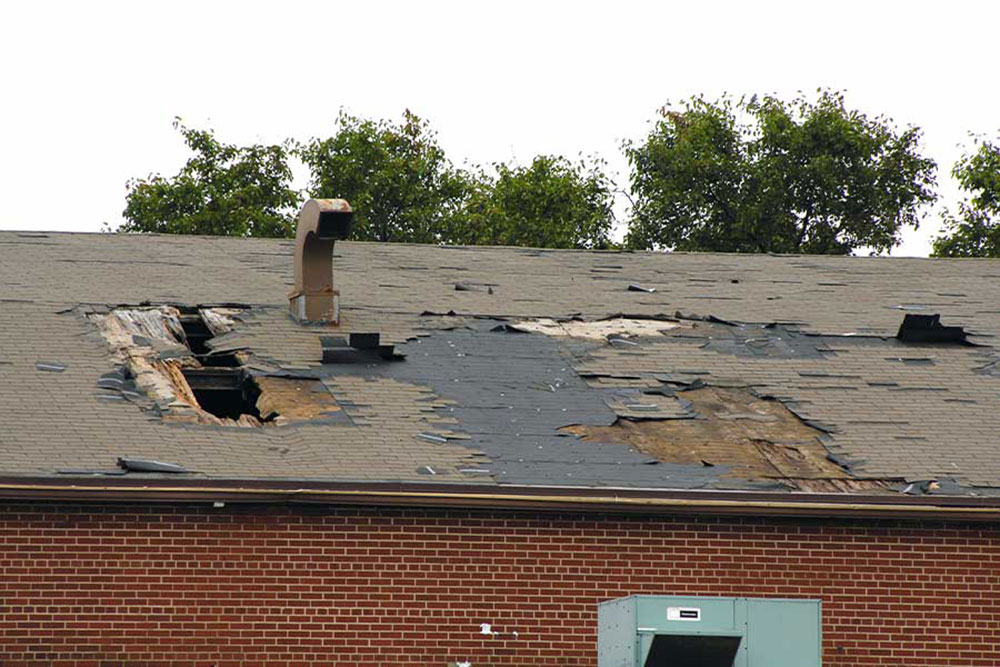Many homeowners who have gone through the nightmare of dealing with roof damage and trying to get their claim approved by the insurance company will agree that it can be difficult to get a claim paid at times. Unfortunately, if you do not follow the correct procedures when filing a roof claim, your insurance company may deny your claim due to an administrative error. Dealing with your insurance company may appear to be a difficult task, but don’t worry. We’ll give you all the information you need to get your insurance company to pay for a new roof or replacement in a few simple steps – as well as how to keep your roof damage-free in the future.
Will your insurance cover the cost of a new roof?
So, will your insurance pay the cost of your new roof replacement? The answer is yes, but only under certain conditions.
Your roof must have storm damage caused by extreme weather in order for your homeowners’ insurance to pay the cost of replacement. Straight-line winds (also known as damaging winds) occur during heavy thunderstorms, hail storms, snowstorms, and tornadoes.
They’ll also cover roof damage caused by fallen tree limbs during severe storms. If your roof has extensive damage, there should be no doubt that it will be covered.
However, if your roof is worthy of a full replacement, it will be determined by what the insurance adjuster discovers during their inspection. However, as long as the damage is caused by extreme weather, your homeowner’s insurance should cover the cost of replacing your roof.
Getting Ready for Your Roofing Insurance Claim
Whether you require a few new shingles, a full roof replacement, or one of the more common roof repairs, it’s critical to understand the steps to take when filing an insurance claim with your homeowner’s insurance. Let’s get acquainted with the procedure.
Step #1 Determine What Your Homeowner’s Insurance Policy Covers.
The first step toward a new roof is to review your home insurance policy. Unfortunately, not all roofing issues are covered by a single insurance policy. When preparing to fight for your roof, it’s critical to understand what you’re up against.
You may be out of luck if your homeowner’s insurance policy expressly states that your roofing situation is not covered. If you can read between the lines, you’ll have a better chance of getting your insurance company to pay for roof repair or replacement. Before you begin constructing your claim, ensure you understand exactly what your insurance coverage will cover and what your deductible is. Consider it a red flag if your roofing contractor offers to waive your deductible.
Texas House Bill 2102 was signed into law by the state of Texas in September of 2019. As a result of this law, North Texas roofers are no longer allowed to offer homeowners a “free roof” by covering deductible costs. Roofing contractors may face jail time if they offer to pay, waive, absorb, rebate, or offset an insurance deductible without explicitly stating in their contract that the homeowner must pay the deductible under their property insurance policy. If you live in Northern Texas, you may also be required to provide proof of payment by the policyholder to your insurance company.
Step #2 Photograph The Damage To Your Roof.

When it comes to documenting the damage to your roof, a picture is worth a thousand words. There’s no better way to get your point across to your insurance company than with plenty of visual evidence.
Even if you don’t currently have any damage to your roof, it’s a good idea to have a few before-damage photos on hand. These will be invaluable if your roof is ever damaged. It will increase your chances of receiving some additional assistance from your insurer.
Don’t worry if you don’t have any before photos. Photographs of the damage are equally useful during the claims process. Make certain that each image has a timestamp. This way, you can link the visible damage to an event like a bad hail storm or a typical Florida hurricane, where your shingle roof may sustain wind damage.
The greater the amount of evidence and documentation you have, the better.
Step #3. Determine the age of your roof.
During the claims process, knowing the age of your roof is critical. The age of your roof will influence the amount of any insurance checks you receive. Roofs that are less than ten years old are typically fully covered under warranty. Roofs that are a decade or older will receive reimbursement or the depreciated value of the roof. Unfortunately, your insurance company’s willingness to pay for roof repair or replacement will reflect this depreciation.
Even if depreciation threatens your roof insurance claim, you must proceed. Any money you can put toward a new roof is preferable to none at all!
Step #4. Consult With a Professional Roofing Contractor About The Damage.
A full assessment from a professional roofer is one of the best pieces of documentation you can present to your insurance adjuster. This inspection will demonstrate that your roof requires immediate repair and attention, whether you have a few roof leaks, broken gutters, or multiple damaged areas. Depending on the type of roof material you have, it could last anywhere from 15 years. If you have asphalt shingles to up to 50 years if you have a metal roof. This makes routine inspections essential.
Your insurance agent will want to schedule a roof inspection to determine whether you only need minor repairs or a complete roof replacement. This professional statement will help you with your roof insurance claim . Also, it’ll help your insurance company understand exactly what needs to be done to your roof.
Step #5: Locate a Qualified Roofer.
Material defects and consistent repairs are frequently traced back to poor installation or workmanship. One of the most important steps you can take is to find the right roofer for your roof replacement or repair. Compare prices, check references, and be wary of low-ball offers, which can be a red flag.
Step #6. Obtain a Roofing Estimate.
Your insurance agent will want you to obtain an estimate from a reputable roofing company. In some cases, they use their own estimators to determine the cost of repair or replacement as well as the cost of any roofing materials you may require. This step should be simple if you’ve already contacted a roofing contractor to inspect the damaged areas of your roof.
To present to your insurance company, you should obtain specific and detailed written statements from your roofing contractor, as well as proof that the contractor is licensed and insured.
Step #7: Submit a Roofing Claim To Your Insurance company.
You’ve finally made it after jumping through a few hoops! It’s finally time to file your roof insurance claim. To ensure that your roof repairs are covered, the policyholder must file this claim within 30 days of the damage. Once your insurance company has reviewed and approved your claim, you can hire your preferred roofing contractor and begin the roof repair process.
Step #8 Safeguard Your Roof Against Future Damage.
It is critical to take the necessary precautions to keep your roof from becoming damaged in the future. It’s also critical to maintaining your roof on a regular basis. Clean it as needed and keeping it clear of debris after a windstorm or excess water.
Knowing the age of your roof, scheduling regular inspections every few years, and performing consistent roof maintenance are three relatively simple steps you can take to ensure your roof will last for many years.
Keep an eye out for contingency contracts.
While everything may appear to you to be clear, it may not always be the case. This depends on the roofing contractor you’re working with. Most roofers offer a free inspection and estimate of your roof, but muddled within are contingency contracts that appear to the customer as an inspection report. So, while you may believe you’re signing off on the inspection, you may actually be agreeing to have that company complete the work — yet another reason to always read what you’re signing!
Dealing with roof damage is never fun, and when you combine it with insurance, it can be downright overwhelming. When you follow the steps outlined above, you will be able to make a smooth and simple transition to a new roof.
Getting Ready for Future Roof Insurance Claims
Filing a claim is a wake-up call for any homeowner, as well as a lesson for the future. Here’s what we propose for the future:
#1. Have your roof inspected on a regular basis. Maintain it and repair it as needed.
You’ll have a strong case if you can demonstrate that you kept your roof in good condition and that it suddenly became a shambles after a storm.
Request that the inspector document the condition of your roof with photos and a written, signed evaluation of the roof’s condition. Here’s a checklist for inspections:
- Once the roof is 5 years old, asphalt shingles should be replaced once a year.
- After 10 years, wood shingles and shakes should be replaced every 2-3 years.
- After 10 years, clay and concrete tiles should be replaced every 2-3 years.
- So, after 15 years, metal roofs and composite shingles should be replaced every two years.
#2. Document the condition of the roof before and after a major storm.
If a tropical storm, hail storm, hurricane, or severe tornado season is predicted, have your roof inspected. Its state should be documented. When filing a roof insurance claim, before and after photos are the best evidence.
If there isn’t enough time to have a roofer out to inspect the roof, take pictures yourself if possible.
Final Words
If you’ve had trouble getting your insurance company to give you a fair settlement, following these tips may help you get your insurance company to pay for roof replacement if a future claim is required.
How to Get Insurance To Pay for Roof Replacement FAQ’s
What kind of roof damage is covered by insurance?
Fire, wind, and hail damage are all common perils covered by insurance. So, if your roof requires repairs as a result of hail damage or a tree that falls onto it during a windstorm, you may find that your dwelling coverage helps cover the cost.
Should I call my insurance company if my roof is leaking?
Roof leaks are usually covered by home insurance policies if they are caused by a covered, or named, peril. Insurance typically does not cover leaks caused by wear and tear, neglect, mold, or pests. Small leaks may not necessitate a claim, but major damage should be reported to your insurance company as soon as possible.
How much does it cost to tear off and replace a roof?
The average cost to tear off and replace a roof for most homeowners is around $12,000 to $15,000. This price is based on a three-bedroom, two-bathroom home with a walkable roof pitch, minimal roof complexity, and dimensional asphalt shingles.
What is the new roof law in Florida?
Insurance companies may be able to patch rather than replace substantial areas of your hurricane-damaged roof under new legislation passed during Florida’s special session.






